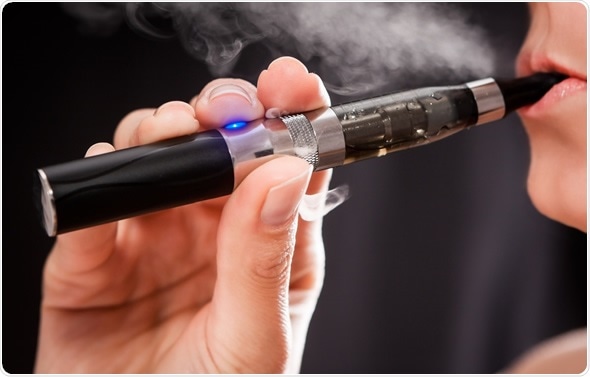E-cigarettes are an alternative to smoking the conventional cigarette. The components of one include a battery, an atomizer and a replaceable cartridge that is designed to hold a nicotine solution and often flavorings for taste.
It works by using a sensor that detects a change in airflow when the user inhales through the device. This begins heating the nicotine solution inside the cartridge until it evaporates and the resulting water vapor is delivered straight into the lungs carrying a certain dose of nicotine with it.

Image Copyright: scyther5 / Shutterstock
Research
The Japanese Ministry of Health has carried out research which claims that e-cigarettes contain 10 times the level of carcinogens than traditional tobacco products. Both formaldehyde and acetaldehyde carcinogens were found in the liquid produced by a number of e-cigarettes. These two chemicals have also been found in experimentation by the Center for Environmental Health (CEH).
It has been shown that when e-cigarettes are run at high voltages the vapor produced contains high enough levels of formaldehyde-containing compounds to drastically increase a person's risk of developing cancer – this risk can be up to 15 times higher than that incurred by long-term smoking.
At this voltage, smoking would prove to be of particular risk to users who use this as a way to increase the delivery of vaporized nicotine. As more recent versions of e-cigs are released which allow users to operate them at higher temperatures, the production of these formaldehyde-containing compounds, and the problems that they result in become even more common. These versions allow users the option to replace their own cartridges, alter the running temperature and consequently, the vapor produced.
Harmful Agents
There is no dispute as to whether formaldehyde and acetaldehyde are harmful when produced - both are listed as probable cancer-causing agents by the Environmental Protection Agency.
The issue lies in the question of whether formaldehyde-releasing agents are being produced. Research has found that when e-cigarettes are used at lower, more realistic voltages, no formaldehyde-releasing agents are detected.
The American Vaping Association has argued that such studies proving the alarmingly high production of formaldehyde are based on unrealistic vaping conditions and are therefore misleading to the public. They claim that e-cigarette users would preferably avoid using their device at a high voltage of 5V. In this setting, there is extreme overheating of the e-cig coil which results in the production of formaldehyde. In such a setting the 'dry puff phenomenon’ occurs and the puffs produced exhibit an acrid, bitter and unpleasant taste which does not appeal to e-cig users.
On the other hand, using the e-cig at the lower setting of 3.7 volts (considered realistic) yielded only trace levels of formaldehyde – this level has also been observed in an FDA-approved inhaler designed to help smokers quit.
Another study from Portland State University also explored the amount of formaldehyde produced with respect to the variable voltage of an e-cigarette atomizer. One has shown no formaldehyde produced at 3.3V, while at 5.0 volts formaldehyde levels up to 15 times higher than in tobacco cigarette smoke were measured. Here, formaldehyde-releasing agents (formaldehyde hemiacetals) were found – this is a combination of formaldehyde and alcohols. Not only was there no actual formaldehyde itself produced but there is also no evidence that hemiacetals are toxic or carcinogenic. In fact, it is even possible that these hemiacetals offer protection against damage induced by formaldehyde. Therefore, considering the hemiacetal risk equivalent to that of formaldehyde to calculate the risk of cancer may be unwise.
References
Further Reading